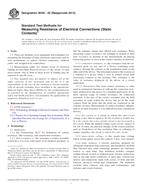Potrebujeme váš súhlas na využitie jednotlivých dát, aby sa vám okrem iného mohli ukazovať informácie týkajúce sa vašich záujmov. Súhlas udelíte kliknutím na tlačidlo „OK“.
ASTM B539-02(2013)
Standard Test Methods for Measuring Resistance of Electrical Connections (Static Contacts)
Automaticky preložený názov:
Štandardné skúšobné metódy pre meranie odporu elektrického pripojenia (Statický Kontakty)
NORMA vydaná dňa 1.8.2013
Informácie o norme:
Označenie normy: ASTM B539-02(2013)
Poznámka: NEPLATNÁ
Dátum vydania normy: 1.8.2013
Kód tovaru: NS-7081
Počet strán: 7
Približná hmotnosť: 21 g (0.05 libier)
Krajina: Americká technická norma
Kategória: Technické normy ASTM
Kategórie - podobné normy:
Anotácia textu normy ASTM B539-02(2013) :
Keywords:
connection resistance, connectors, contact resistance, contacts, electrical resistance, junction resistance, low level contact resistance, separable connections, ICS Number Code 29.120.20 (Connecting devices)
Doplňujúce informácie
| Significance and Use | ||||
|
5.1 As stated in Terminology B542, contact resistance is comprised of a constriction resistance and a film resistance. When present, the latter of these is usually much greater in value and dominates the contact resistance. For a given contact spot, when the film resistance is zero or negligible the contact resistance for that spot is nearly the same as the constriction resistance and therefore, as a practical matter, has a minimum value which represents a clean metal-to-metal contact spot. As real contact surfaces exhibit varying degrees of roughness, real contacts are necessarily composed of many contact spots which are electrically parallel. In practical cases the clean metal-to-metal contact spots will carry most of the current and the total contact resistance is primarily dependent on the size and number of metallic contact spots present (see Note 1). In addition, acceptably low values of contact resistance are often obtained with true areas of contact being significantly less than the apparent contact area. This is the result of having a large number of small contact spots spread out over a relatively large apparent contact area. 5.2 The practical evaluation and
comparison of electrical connections depend in large part on their
contact resistance characteristics. On the one hand, the absolute
value of contact resistance is greatly dependent on the amount of
metallic contact established and indicates initially how efficient
the system is in producing areas of metallic contact. On the other
hand, a comparison of the initial resistance to the resistance
after aging indicates how stable the system is in maintaining the
initial contact area. Both of these characteristics should be
considered when evaluating contact systems. The criteria employed
in evaluating contact resistance and stability are not a part of
these test methods as they depend on specific applications and
therefore, will not be quantitatively stated. However, an estimate
of contact resistance1.1 These test methods cover
equipment and techniques for measuring the resistance of static
electrical connections such as wire terminations or splices,
friction connectors, soldered joints, and wrapped-wire
connections.
1.2 Measurements under two distinct levels of electrical loading are described. These levels are: (1.3 This standard does not purport to address all of the safety concerns, if any, associated with its use. It is the responsibility of the user of this standard to become familiar with all hazards including those identified in the appropriate Material Safety Data Sheet (MSDS) for this product/material as provided by the manufacturer, to establish appropriate safety and health practices, and determine the applicability of regulatory limitations prior to use. |
||||
| 2. Referenced Documents | ||||
|
Odporúčame:
Aktualizácia technických noriem
Chcete mať istotu, že používate len platné technické normy?
Ponúkame Vám riešenie, ktoré Vám zaistí mesačný prehľad o aktuálnosti noriem, ktoré používate.
Chcete vedieť viac informácií ? Pozrite sa na túto stránku.




 Cookies
Cookies
